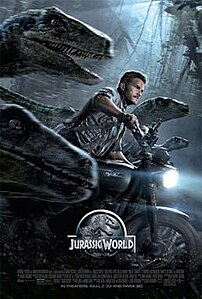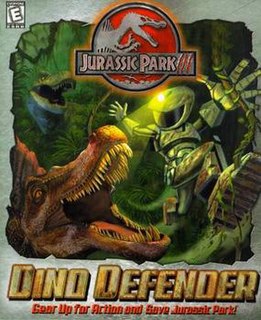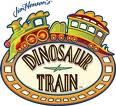
Jurassic Park is a 1993 American science fiction adventure film directed by Steven Spielberg and produced by Kathleen Kennedy and Gerald R. Molen. It is the first installment in the Jurassic Park franchise, and is based on the 1990 novel of the same name by Michael Crichton and a screenplay written by Crichton and David Koepp. The film is set on the fictional island of Isla Nublar, located off Central America's Pacific Coast near Costa Rica. There, wealthy businessman John Hammond and a team of genetic scientists have created a wildlife park of de-extinct dinosaurs. When industrial sabotage leads to a catastrophic shutdown of the park's power facilities and security precautions, a small group of visitors and Hammond's grandchildren struggle to survive and escape the perilous island.

Jurassic Park III is a 2001 American science fiction adventure film and the third installment in the Jurassic Park film series, following The Lost World: Jurassic Park (1997). The film stars Sam Neill, William H. Macy, Téa Leoni, Alessandro Nivola, Trevor Morgan, and Michael Jeter. It was written by Peter Buchman, Alexander Payne and Jim Taylor, and was directed by Joe Johnston. It is the first film in the franchise to not be directed by Steven Spielberg, who served as executive producer instead. It is also the franchise's first film to not be based on a novel by Michael Crichton, although the film includes characters and ideas by him, including scenes from his first novel Jurassic Park (1990).

Isla Nublar is a fictional Central American island in the Jurassic Park franchise, first depicted in Michael Crichton's eponymous 1990 novel. It is the primary setting of the 1993 film Jurassic Park, Jurassic World (2015) and Jurassic World: Fallen Kingdom (2018). Both the novel and film versions of the Jurassic Park theme park are located on Isla Nublar off the west coast of Costa Rica, which has leased the island to John Hammond, the CEO of fictional bio-engineering firm InGen.
Jurassic Park III is a light gun arcade game based on the 2001 film of the same name. The game was developed by Konami and was first unveiled at the Japan Amusement Machinery Manufacturers Association in September 2001. The game had been released in Japan by November 2001, and was later released in the United States in March 2002. The game uses the same cabinet and motion sensor technology as Police 911, requiring players to dodge the oncoming dinosaur attacks. Alternatively, the standard cabinet provides a left and right button to perform evasive maneuvers. It was preceded by The Lost World: Jurassic Park in 1997, also a light gun game, but from Sega.
Jurassic Park is a rail shooter arcade game developed and released by Sega in 1994. It is based on the 1993 film of the same name. The game cabinet resembles the rear of the Ford Explorer tour vehicles used in the film. The player, equipped with a joystick, must shoot dinosaurs that appear on-screen throughout the game.

Jurassic World is a 2015 American science fiction adventure film. It is the fourth installment of the Jurassic Park film series and the first installment in the Jurassic World trilogy, while also serving as a direct sequel to the franchise's first film, Jurassic Park (1993). It was directed by Colin Trevorrow, written by Derek Connolly and Trevorrow, produced by Frank Marshall and Patrick Crowley, and stars Chris Pratt, Bryce Dallas Howard, Vincent D'Onofrio, Ty Simpkins, Nick Robinson, Omar Sy, BD Wong, and Irrfan Khan. Set 22 years after the events of Jurassic Park, Jurassic World takes place on the same fictional Central American island of Isla Nublar, which is located off the Pacific coast of Costa Rica, where a theme park of cloned dinosaurs has operated for nearly a decade. The park plunges into chaos when a transgenic dinosaur escapes from its enclosure and goes on a rampage.

The Truth About Killer Dinosaurs is a two-part BBC documentary, presented by Bill Oddie, in which a group of scientists test out the strength of dinosaur weaponry using biomechanics. The first episode determines the winner of a battle between Tyrannosaurus and Triceratops, and the second compares the strength of an ankylosaur and Velociraptor. The episodes were broadcast on BBC 1 in August and September 2005. In the U.S., The Truth About Killer Dinosaurs was known as Dinosaur Face-Off.
Tyrannosaurus rex is one of the most famous dinosaurs. It has been frequently represented in film and on television, in literature, on the Internet and in all kinds of games.

Jurassic Park: The Ride is a water-based amusement ride based on the Steven Spielberg 1993 film Jurassic Park and Michael Crichton's 1990 novel of the same name which the film is based on located at Universal Orlando's Islands of Adventure in Orlando, Florida and Universal Studios Japan in Osaka, Japan. It was formerly located at Universal Studios Hollywood in Los Angeles, California, where it was turned into Jurassic World: The Ride.
The Carnegie Collection was a series of authentic replicas based on dinosaurs and other extinct prehistoric creatures, using fossils featured at the Carnegie Museum of Natural History as references. The line was produced by Florida-based company Safari Ltd., known for their hand-painted replicas, from 1988 to 2015, and became known as "the world’s premier line of scale model dinosaur figures."

Jurassic Park, later also referred to as Jurassic World, is an American science fiction media franchise centered on a disastrous attempt to create a theme park of cloned dinosaurs. It began in 1990 when Universal Pictures and Amblin Entertainment bought the rights to the novel by Michael Crichton before it was published. The book was successful, as was Steven Spielberg's 1993 film adaptation. The film received a theatrical 3D re-release in 2013, and was selected in 2018 for preservation in the United States National Film Registry by the Library of Congress as being "culturally, historically, or aesthetically significant".

Jurassic Park III: Dino Defender is a 2001 side-scrolling video game developed and published by Knowledge Adventure. It is based on the 2001 film Jurassic Park III. The player is depicted as a person in a bio-mechanical suit hired by Jurassic Park to bring power back to the electrified fences and capture all the free-roaming dinosaurs.

Jurassic Park Adventures: Survivor is the first installment in the Jurassic Park Adventures book series by Scott Ciencin.

Dinosaur Train is an American-Canadian-Singaporean children's computer-animated television series created by Craig Bartlett, who also created Hey Arnold! and Ready Jet Go!. The series features a curious young Tyrannosaurus rex named Buddy who, together with his adopted Pteranodon family, takes the Dinosaur Train to explore his time period, and have adventures with all kinds of dinosaurs. It is produced by The Jim Henson Company in association with the Info-communications Media Development Authority, Sparky Animation, FableVision, and Snee-Oosh, Inc. and Reel FX and Sea to Sky Entertainment. As of September 2018, PBS Kids had ordered 11 more episodes, taking the total number of episodes to 100. A film based on the series was announced in 2020.
Jurassic Park Arcade is a 2015 light gun arcade game developed by Raw Thrills. The game is based on the first three films of the Jurassic Park series.

Jurassic World: Fallen Kingdom is a 2018 American science fiction adventure film and the sequel to Jurassic World (2015). Directed by J. A. Bayona, it is the second installment of the planned Jurassic World trilogy, and the fifth overall installment of the Jurassic Park film series. Derek Connolly and Jurassic World director Colin Trevorrow returned as writers, with Trevorrow and the original 1993 Jurassic Park director Steven Spielberg as executive producers.
Jurassic World: The Ride is a dark ride / water ride attraction that is themed to the Jurassic World series at Universal Studios Hollywood. The original Jurassic Park: The Ride, which operated from June 21, 1996, to September 3, 2018, underwent a major refurbishment and reopened as Jurassic World: The Ride.
Lego Jurassic World: The Indominus Escape is a film based on Jurassic World. It was originally a five-part miniseries before it was merged into a film that was bundled with Jurassic World that was released on October 18, 2016.
Lego Jurassic World is a Lego theme based on the same name of the film, licensed from Universal Studios. The theme was first introduced in 2015. The first sets appeared in 2015, to coincide with the release of the first film, Jurassic World. Subsequent sets were released alongside the next film, Jurassic World: Fallen Kingdom. In 2018, it was announced that more sets based on the Jurassic Park/World franchise would be released, including new sets based on Jurassic Park and miniseries, Lego Jurassic World: Legend of Isla Nublar.











